Green Design Shines at Infill Philadelphia: Soak It Up Awards
By Bustler Editors|
Tuesday, Mar 12, 2013
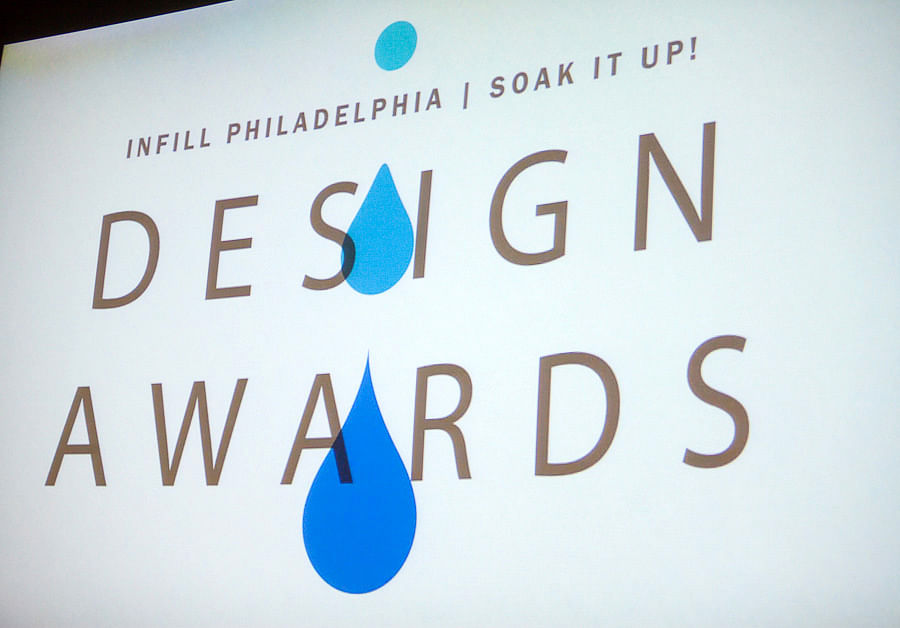
Related
How does one apply 21st century green design to a city with sites and structures dating from the 17th to 19th centuries? That was exactly the challenge for teams in the Infill Philadelphia: Soak It Up design competition, and on March 7, 2013, nine finalist teams presented proposals to address the need for affordable green design within Philadelphia at the Academy of Natural Sciences of Drexel University.
“On this nineteenth century site, a twenty-first century approach to rain can help renew not only the urban hydrology but the urban fabric itself,” stated Muscoe Martin of m2 Architecture and co-presenter for one of the three winning entries.
The Infill Philadelphia: Soak It Up competition was one of the most unique and robust design competitions created to address challenges of green stormwater design and infrastructure. The contest, created by the Philadelphia Water Department, the United States Environmental Protection Agency (EPA), and Community Design Collaborative was aimed to inspire multidisciplinary teams to present plans in one of three sites, each with a predominate land-use: industrial, retail commercial residential. In creating designs for one of the select urban-based environments, teams had to include architects, artists, engineers, and other sustainable professionals. Additionally, community-based non-profits and local residents served as advisors to the competing teams which spanned from New York to Washington State. Ultimately, each project proposal had to meet three stringent criteria to ensure the ideas were implementable:
- Represent innovative, cost effective design
- Help public, private and non-profit property owners see return on capital invstments
- Serve as prototypes for green water infrastructure

“Feasibility was definitely a top criterion,” stated Ken Hendrickson, EPA, Office of State and Watershed Partnerships. “You can have pie-in-the-sky ideas but if you can’t get them on the ground, in the end, what’s the benefit? We’ve seen some designs that are modular, others that can be phased, and even some where you don’t necessarily have to take every piece of it to make it work.”
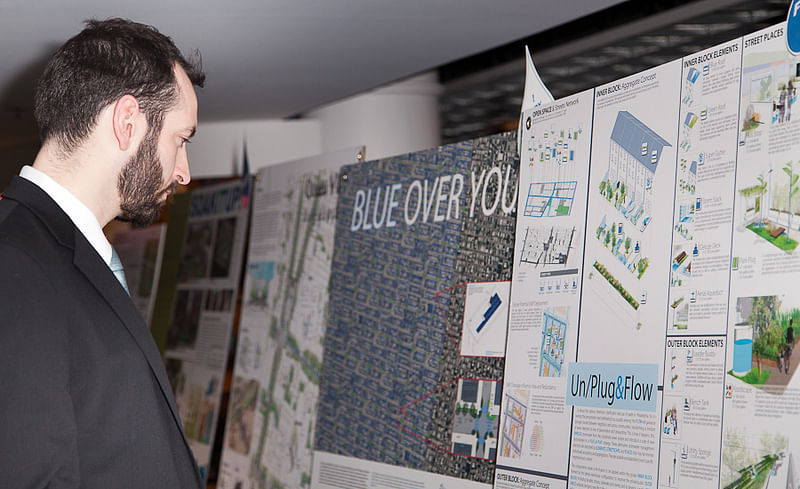
In total, 28 teams representing more than 100 firms and 300 design professionals entered the competition. Judging went through an initial round which reduced the entries to the nine finalists or three for each category: Industrial, Commercial, Neighborhood. The final round of judging was done based on the PechaKucha style in which two team representatives were allotted six minutes forty seconds to present their proposal. Judges selected the final winners based on their overall presentations and the degree to which the designs addressed environmental management, storm-water health, and revitalizing the community. Winning teams received a $10,000 prize, but ultimately the winners included a much broader group, that being the city of Philadelphia and the various communities committed to efficient and sustainable environmental infrastructure.
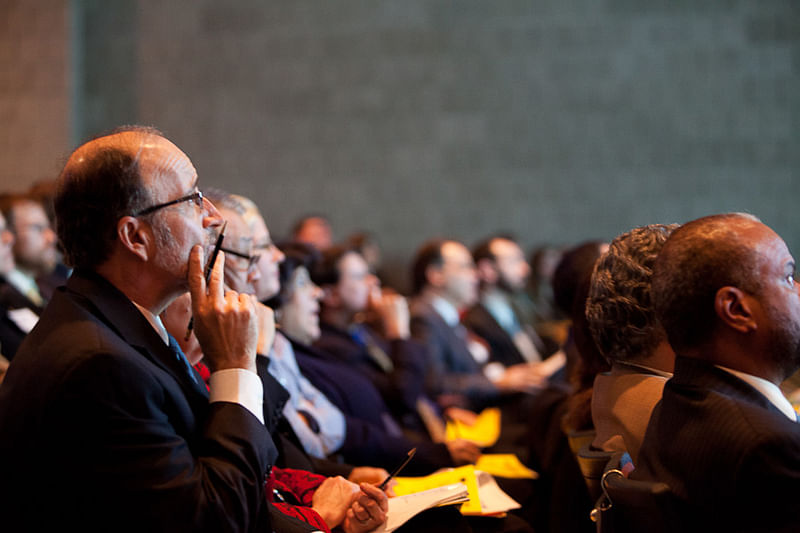
“The idea is about the site – that’s the basis of each design project – but it’s also about the city, what we do in a small way and in specific ways that have a high degree of replication that could also be taken to other cities,” stated Robert Rogers, Rogers Marvel Architects and finalist presenter.
Paul Vernon, Board Member, Community Design Collaborative noted that while the designs were definitely implementable, that didn’t mean they lacked depth and complexity.
“The interesting thing is these designs ranged from the highly technical, some of them were very engineer driven and focused on statistics which is incredibly important in making these things happen, and some of the presentations were sort of tangible, including every day implementable tool kit items that you, I, or anybody could understand,” remarked Vernon.
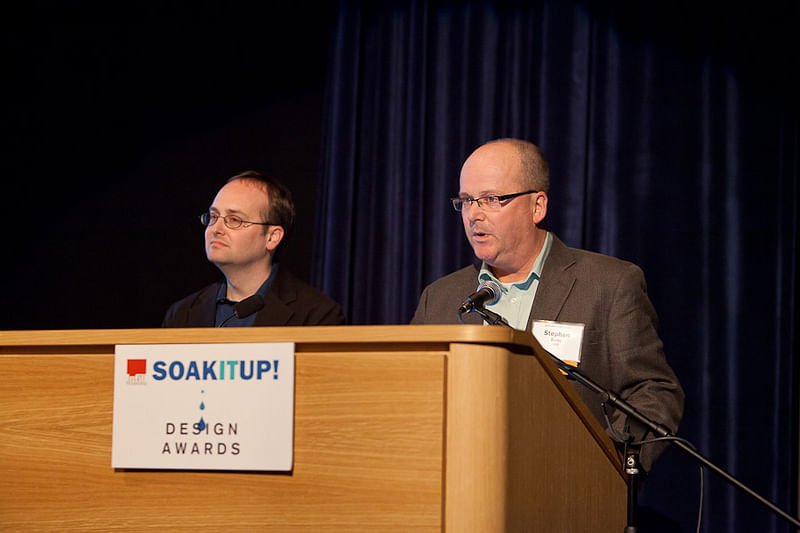
THE WINNING ENTRIES
Vernon’s observation of the designs ranging from the technical to the tangible is certainly applicable. However, the thing that judges like Tavis Dockwiller, Community Design Collaborative Board Member and founder of Veridian Landscapes Studio noticed was the possibility that various elements from different proposals could work together.
“While the desire is to let each project stand on its own merit, we clearly see components of different projects working well together,” stated Dockwiller. “It’s actually a reflection of the kind of excitement we hoped the competition would bring, different disciplines and different communities all talking together about being greener in a smarter, more cost efficient way.”
COMMERCIAL: "Stormwater reStore"
Infill Philadelphia: Soak It Up! - Stormwater reStore from cdesignc
The Commercial/Retail Retrofit winner entitled “Stormwater reStore” looked at a strip shopping center common to Philadelphia. In typical fashion the property site expands more than 10 acres, has large areas of impervious surfaces including parking lot pavements, driveways and large areas of unutilized roof area.
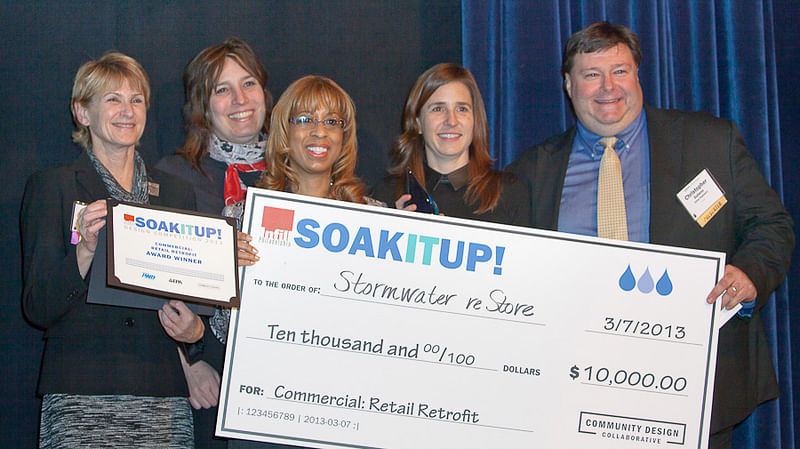
The “Stormwater reStore” team, represented by Christopher Gubeno, Urban Engineers, Inc. (Philadelphia) and Johanna Phelps, Matthew Nielsen Landscape Architects (New York) focused on small incremental improvements that would collectively make a large overall impact. Some of the proposals for their plan included:
- Installing rainwater capture islands via the existing parking lot by reducing the 28-foot wide drive aisles down to 24 feet, which doesn’t require repaving the parking lot to install
- Planting more than 30 trees to create more than 1,000 linear feet of greenscape
- Installing rain gardens and creating a 22 foot wide green way
NEIGHBORHOOD: "Meeting Green"
Infill Philadelphia: Soak It Up- Meeting Green from cdesignc
The green revamping of commercial space would certainly have an impact on the Philadelphia landscape but as the winning team for the “Meeting Green” project would attest the strength and charm of the city lies within its residential areas.
“Meeting Green” was presented by Stephen Benz and Richard Roark, OLIN (Philadelphia). The project focused on the Queen Village area of Philadelphia which according to Benz and Roark was a test for their hypothesis on how green infrastructure could reinforce the very fabric of community while enhancing the lives of Philadelphians. The “Meeting Green” team presented an alternative to current infrastructure solutions and policies which are usually for large public and privately owned parcels which they stated “are in locations where the people aren’t, and we need to look at where the people are.”

The main premise of the “Meeting Green” design is to create a series of primary and secondary or branching green conduits that thread through the neighborhood and across the city to create a holistic green network. With lot parcels smaller than 15,000 feet in area, Queen Village is a small depiction of broader Philadelphia’s diverse and historic neighborhoods. Proposals such as installing permeable pavement plazas, storm water infiltration trenches and decorative rain spouts are all center stage to making Queen Village a transformative place.
If the residential and commercial space designs reflected the everyday tangible components as Vernon stated, the Industrial Warehouse Watershed project highlighted the technical innovation that could be implemented in cost efficient ways to change large industrial sites.
INDUSTRIAL: "Leveraging Water + Plants in Zero Lot Sites"
Infill Philadelphia: Soak It Up! - Leveraging Water and Plants in Zero Lot Sites from cdesignc
The winning Industrial project “Leveraging Water + Plants in Zero Lot Sites” was presented by Laura Hansplant, Roofmeadow (Philadelphia) and Muscoe Martin, m2 Architecture (Philadelphia). The “Leveraging Water” plan encompassed five integrated strategies to transform the water, place and surrounding community.

Components of the integrated strategies include:
- Dividing the warehouse roof into separate drainage areas, such as a perimeter zone where rainwater flows into decorative cisterns that can be spread around the four sides of the building
- Combining thin green roofs with shallow roof sections that together detain significant amounts of runoff while keeping roof weight and cost manageable; the runoff can be used to maintain rooftop plant life or be directed to other parts of the overall design
- Installing rainwater courtyards using collected rooftop runoff. Indoor courtyards can allow more natural light and deeper visibility into the structure to attract new uses and new tenants while exterior courtyards can be public or private gathering spaces
- The use of tree trenches serves to capture rain runoff from adjacent streets with water flowing to a spring point. Installing a series of tree trenches allows for the connection between various greening elements of the site design
- Inclusion of rain gardens would also manage rainwater and serve the community by being designed as decorative and useable spaces such as an open playspace for children or a much-needed dog park
The Infill Philadelphia: Soak It Up competition brought forth tremendous innovation in the area of storm water management design. More importantly it elevated the recognition and understanding that green infrastructure design, when undertaken with the right multidisciplinary approach, could be implemented in cost efficient and creative ways that benefit municipalities, businesses, residents and the environment.
As Martin astutely stated “Storm water is a problem, rainwater is an opportunity.”
Images & article by Gregory Clarke, CG Lawrence Photography.

Share
0 Comments
Comment as :